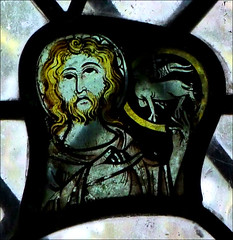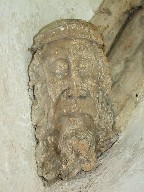| |
|
 |
|
Pity the villages which are
touched by the hellish A140 Ipswich to
Norwich road, its lorries hurtling
through the night in each direction on
their single lanes. Part of Thwaite
actually lies along the road, but there
is a prettier, gentler part of the
village not far from the road,
surrounding St George's squarish
graveyard. The parish room on the
northern edge is a curious survival. When
I first came this way in 1998, I was
saddened to find a neglected, ramshackle
church with the only locked door for
miles around. It was, in fact, in its
last days of usage, although I didn't
know that then. I observed on an earlier
entry that a
sign on the door warned of an uneven
floor and crumbling masonry, and
all around me the graveyard was dank and
overgrown, and clearly used by locals for
exercising their dogs, which was a bit
disgusting. From the outside, you could
see that this is basically a 12th century
church at heart, but the chancel and west
wall are thoroughly Victorian.The tower
fell in the early 19th century, and
Mortlock observes that the rubble was
used to build the pair of cottages
adjacent to the churchyard.
Since my first visit, this
poor little church has undergone
something of a roller coaster ride. It
was abandoned about ten years ago, and
plans were discussed for turning it into
a village hall. However, these plans seem
to have been scuppered by a lack of
interest among locals.
|
Indeed,
the salvation of the building came from people
who had moved into the village from outside, and
it was from one of these that I went to get the
key. The sign warning of the uneven floor had
been renewed, although there are even greater
dangers, as we shall see. Beside the warning sign
was a keyholder notice, a cause for optimism.
However, it must be said that when I knocked on
his door he was not terribly pleased to see me,
as he was just about to sit down to his lunch. He
couldn't let me have the key, as the church was
too dangerous to enter unsupervised, but he
offered us five minutes of his time. As is often
the way, he ended up giving us four times as
long.
One
of the most remarkable features of Thwaite church
is visible without getting the key. This is the
set of extraordinary headstops which support the
porch roof. They are apparently 16th century, and
appear to be deliberately pulling ugly faces. It
is fascinating to wonder if they were based on
real, contemporary people. Above the porch, the
roof of the church is in a parlous state, the
guttering coming away and the tiles sagging. This
was the reason for the keyholder's caution -
already one part of the ceiling had fallen in,
and there was concern for other stretches.
And
yet, we stepped into a church which felt cared
for and loved. As well it might, for a small
group of villagers have really begun to get to
grips with the place. About five years ago they
formed a trust and began to raise money and carry
out essential repairs, but they found the Diocese
of St Edmundsbury and Ipswich obstructive and
generally unhelpful. The working group threatened
to walk away and abandon it again, so the Diocese
reluctantly declared it redundant and sold it to
the trust for a pound. Since then, the work has
continued, although a fabulous six figure sum
would still be needed to get the building
thoroughly ship shape again, and this is not a
good time for fund-raising.
Despite
the long years of neglect, the medieval features
of St George have survived intact, most famously
the 15th Century pulpit, but also part of a 15th
Century glass figure of St John the Baptist, set
in the east window. It may very well not have
come from here originally, but it certainly has
pride of place now.
| At the west end is a
lozenge-patterned window by Charles
Clutterbuck, of which Mortlock speaks
highly. Again, it is in need of repair,
not least because of the weight of the
bell turret above it. George Thomas
Carpenter, an Edwardian Rector of this
place, is remembered tenderly by a
lozenge on the south wall. The organ is
apparently still playable - indeed, the
keyholder told me that he and his
grandson like to come down to the church
and play it, which I thought was lovely.
In the long run, the future of this
building must be as a village hall of
some kind, with the eastern end retaining
its liturgical integrity for use at
Christmas, Easter, Remembrance Sunday and
so on, although it has to be said that
this goal still seems rather remote at
present. However, I think that Thwaite
church is now in safe hands, which it
certainly wasn't ten years ago. I
wondered what Orlando Whistlecraft might
of made of it all. He was Thwaite's most
famous former resident, a self-styled
weather prophet and poet. He
meticulously recorded the weather for
almost seventy years in the 19th Century,
leaving a valuable archive. He wrote
about the changing seasons, and used his
observations to make predictions for
local farmers. His cast iron gravemarker
is immediately to the east of the church.
|
|
 |
|
|
|

